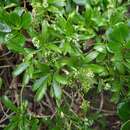pt-BR
nomes no trilho de navegação


Lepidium oleraceum (lat. Lepidium oleraceum) - kələmçiçəyikimilər fəsiləsinin bozalaq cinsinə aid bitki növü.
Lepidium oleraceum (lat. Lepidium oleraceum) - kələmçiçəyikimilər fəsiləsinin bozalaq cinsinə aid bitki növü.
Lepidium oleraceum is a herb in the family Brassicaceae, endemic to New Zealand. Its English common name is Cook's scurvy grass; Māori names include nau, ngau, naunau and heketara.[1][2]
Its specific epithet oleraceum means "vegetable/herbal" in Latin and is a form of holeraceus (oleraceus).[3][4]
There are three recognised varieties:[5]
In New Zealand it is native to coastal areas of the North and South Islands, Stewart Island, the Three Kings Islands, the Snares Islands, the Chatham Islands, the Auckland Islands, the Antipodes Islands and the Bounty Islands.[5][6] Although this species was once widespread, it is now mostly restricted to off-shore rock stacks and islets.[7]
The small populations are highly threatened, one of the reasons being reduced populations of seabirds which they are dependent on to provide highly fertile and disturbed soils associated with nesting grounds. Additionally the species is susceptible to browsing by livestock, rodents, snails, and insect herbivores such as aphids, leaf miners, the diamondback moth (Plutella xylostella), and the small cabbage white butterfly (Pieris rapae).[8] It is also affected by white rust, a fungus-like disease caused by the oomycete Albugo candida.[7][8]
During his voyages of exploration James Cook collected a number of plant species at various locations which were used to help ward off scurvy amongst his crew. While visiting Tolaga Bay in New Zealand on his first voyage, Cook noted in his journal on 27 October 1769: "the other place I landed at was the north point of the Bay where I got as much Sellery and Scurvy grass as loaded the Boat".[9] Historian John Cawte Beaglehole believed that "scurvy grass" in this case referred to Lepidium oleraceum.[9] Specimens of the plant were collected by botanists Johann and Georg Forster on Cook's second voyage. [10]
Young leaves may be eaten raw or cooked. They have a hot cress-like taste and are a rich source of vitamin C.[11]
Lepidium oleraceum is a herb in the family Brassicaceae, endemic to New Zealand. Its English common name is Cook's scurvy grass; Māori names include nau, ngau, naunau and heketara.
Its specific epithet oleraceum means "vegetable/herbal" in Latin and is a form of holeraceus (oleraceus).
Lepidium oleraceum là một loài thực vật có hoa trong họ Cải. Loài này được mô tả khoa học đầu tiên.[1]
Lepidium oleraceum là một loài thực vật có hoa trong họ Cải. Loài này được mô tả khoa học đầu tiên.
沿海捲心菜(学名:Lepidium oleraceum)[1]为十字花科独行菜属的草本植物,原生於紐西蘭,是紐西蘭的特有種。[2][3]。
本物種現時有三個已知的變種[4]:
在紐西蘭,本物種原生於各處的海岸,包括有:北島、南島、 斯圖爾特島、三王群岛、斯奈尔斯群岛、查塔姆群岛、奥克兰群岛、安蒂波德斯群岛及邦蒂群岛[4][5]。 雖然當歐洲人初來紐西蘭時,本物種大量曾經到處都是[6][7][1],但現時主要都只在離岸的石堆或洲渚(英语:islet)之上[8]。
現時本物種的數量很少,屬於高危類別。當中一個原因是這些物種依賴數量在減少中的海鳥,當牠們築巢時,為泥土帶來的高度營養。另外,本物種亦會被多㮔動物食用,例如:牲畜、嚙齒類、蝸牛及素食類昆蟲諸如小菜蛾、菜粉蝶等[6]。植株也會感染白銹病(white rust),白銹病是由卵菌綱的病原菌白銹菌(Albugo candida)所造成的。[8][6]
本物種的嫩葉可生吃或煮熟來吃。含有豐富的維生素C,早從大航海時代就已經是重要的維生素C來源,令航海者免於患上壞血病[1][9]。葉子的味道與水芹相似[9]。